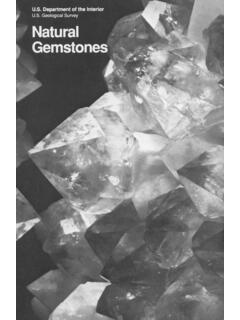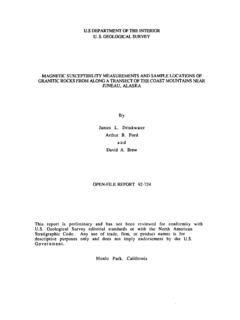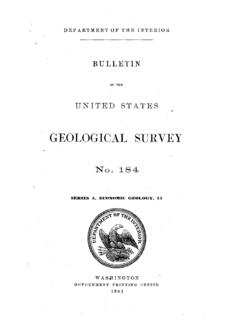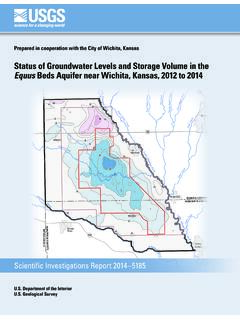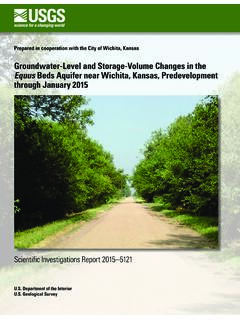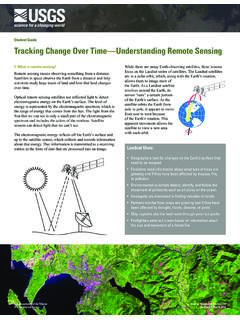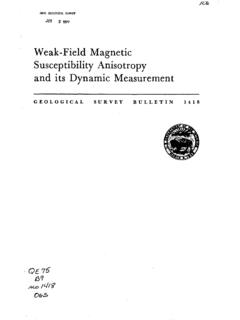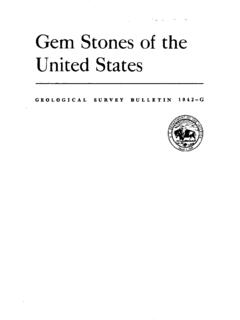Transcription of A Simple Method for Determining Specific Yield from ...
1 A Simple Method for Determining Specific Yield from Pumping TestsBy L. E. RAMSAHOYE and S. M. LANGGROUND-WATER HYDRAULICSGEOLOGICAL survey WATER-SUPPLY PAPER 1S36-CPrepared in cooperation with theNew jersey Department of Conservationand Economic DevelopmentUNITED STATES GOVERNMENT PRINTING OFFICE, WASHINGTON t DEPARTMENT OF THE INTERIOR BRUCE BABBITT, geological survey Robert M. Hirsch, Acting DirectorAny use of trade, product, or firm names in this publication is fordescriptive purposes only and does not imply endorsement by GovernmentFirst printing 1961 Second printing 1965 Third printing 1993 For sale by geological survey , Map DistributionBox 25286, MS 306, Federal CenterDenver, CO 80225 CONTENTSPage Abstract- _____ 41 Introduction_____ 41 Application to test data from Kearney, 45 Literature cited_____ 46 ILLUSTRATIONSFIGURE 11.
2 Diagram showing drawdown of the water table in the vicinityof a pumped 42inGROUND-WATER HYDRAULICSA Simple Method FOR Determining Specific Yield FROM PUMPING TESTSBy L. E. RAMSAHOYE and S. M. LANGABSTRACTA simpler solution which greatly reduces the time necessary to compute the Specific Yield by the pumping-test Method of Remson and Lang (1955) is presented. The Method consists of computing the volume of dewatered material in the cone of depression and comparing it with the total volume of discharged water. The original Method entails the use of a slowly converging series to compute the volume of dewatered material. The solution given herein is derived directly from Darcy's pumping-test Method to determine the Specific Yield of a water- table aquifer was presented by Remson and Lang (1955).
3 The Method involves the determination of the volume of dewatered material in the cone of depression during the course of a pumping test. The Specific Yield is then determined by comparing the volume of dewatered material with the total volume of discharged calculation of the volume of dewatered material requires the solution of an exponential series that converges very slowly and is, therefore, time consuming. The example presented by Remson and Lang needed 60 terms of the series and required more than ? hours of computation. This paper presents a more easily evaluated equation for rapidly computing the volume of dewatered material in the cone of work was carried out under the supervision of Aller Sinnott, district geologist, as part of the investigation of the ground-water resources of New jersey in cooperation with the New jersey Depart- ment of Conservation and Economic Development.
4 The senior author, a hydrologist-geophysicist with the British Guiana geological survey , participated in this study as a foreign trainee unde^ the pro- gram sponsored by the International Cooperation pointed out by Remson and Lang, it may not be possible to apply the standard formulas to data from a pumping test in a shallow water- table aquifer because of the slow drainage of the aquifer material4142 GROUND-WATER HYDRAULICS during the test and (or) because of a varying rate of discharge. How- ever, the general equilibrium formula can be applied if a pumping rate Q is constant for a long enough period so that the cone of depression reaches approximate equilibrium form and is declining only very slowly.
5 The condition of approximate equilibrium is described by Wenzel (1942, p. 98-99),.. as pumping continues, a hydraulic gradient that is essentially an equilibrium gradient will be established close to the pumped well, and water will be trans- mitted to the well through the water-bearing material in approximately the amount that is being pumped. The decline of the water table and the resulting unwatering of material in this area will then be much assumptions used in the development of the general equilibrium formula and those used by Remson and Lang also apply here. The following is quoted from Remson and Lang (1955, p. 322). "Although the water table continues to decline slowly, the assumption that steady-state conditions have been reached involves only , slight error no greater than that resulting from such a cause as fluctuation in pump discharge.
6 " The following paragraph, adapted from Wenzel (1942, p. 77), describes the requisite conditions of the test:An isotropic and homogeneous water-bearing bed of infinite extent is assumed to rest on a relatively impervious formation. The discharging well, equipped with a pump, is fully screened to the bottom of the water-bearing material. It is assumed that water movement from the outer radiu? of the screenPumped wellGround surfaceFIGUBE 11. Diagram showing drawdown of the water table In the vicinity of a prmped FOR Determining Specific Yield FROM PUMPING TESTS 43to the pump intake occurs without loss of head or with a head loss that is regligible compared with the drawdown in the well.
7 The water table before pumping, and the underlying impervious bed, are assumed to be horizontal. It is assumed also that there is no recharge to the aquifer during the test and that all the water pumped is removed from 11 shows the shape of the cone of depression in the vicinity of a well pumping from a water-table following symbols or nomenclature are used in the mathemati- cal derivations in this report :Q=the discharge rate of the pumped well in gallons per day P=the field coefficient of permeability of the aquifer in gallons per day per square foot under a unit hydraulic gradient and at the prevailing water temperature r = the horizontal distance from the axis of the pumped well to a point on thecone of depression, in feet s = the drawdown at distance r, in feets tt = the drawdown just outside the screen of the pumped well, in fe t m=the thickness of the zone of saturation before pumping or the height ofthe static water table above the aquifer bottom.
8 In feet T Pm= the coefficient of transmissibility of the aquifer in gallons pe^ day per foot. It is the flow through a vertical strip of the aquifer 1 foot wide and extending the saturated height of the aquifer, at unit hydraulic Darcy's law:Q=27rrP(-^)(m~S) (1) ThereforeQ wheredr , . T , x 7 /c^. (m s)ds= a(m s)ds (2)Integrating,as2 Inr ams+- -=-- f InB (3)zwhere B is the constant of integration. Thenr^Be- '**2'* (4)Equation 4 describes the cone of depression when it has reached virtually an equilibrium shape or volume of dewatered material in cubic feet, V, within the cone of depression is(5)44 GROUND-WATER HYDRAULICSthe limits of integration being chosen at zero drawdown (for example, the extent of the cone at equilibrium) and the drawdown outside the screen of the pumped well.
9 The value for r in equation 4 may be substituted in equation 5 to give'ds (6)Observe in equation 6 that the exponent of e may be written in the equivalent form [ 2ams(l sj2m)].Because s/2m is generally very small compared to unity, it may be neglected; therefore equation 6 becomes2amt fa (7)2amFor values found during field pumping tests2amsw>lHence 2amtu is very small and can be neglected. Thu^ equation 9 becomes(10)'From equation 4 B=ream - a**i'iSubstituting the value for B in equation 10 there follow?2amIf the exponent of e is again modified, in the manner shown in writing equation 7, it follows that equation 11 may be written in the form2amIn equation lla the volume of dewatered material is expressed in terms of permeability, pumping rate, horizontal distance, drawdown, Method FOR Determining Specific Yield FROM PUMPING TESTS 45and aquifer thickness.
10 In field practice, it is often necessary to make pumping tests, using wells that only partly penetrate the aquifer or for which incomplete data are available. Thus, it may not be possible to determine the coefficient of permeability, P, or the full thickness, m. Under such circumstances, equation 10 canrot be used to determine the volume of dewatered material in the cone of depression. However, if the drawdown, s, at the point of observation is small compared to suspected thickness of the zone of saturation, the thickness may be assumed to remain uniform and transmissibility, T, may be used in place of the unknown permeability and rquifer thickness (T=Pm).
